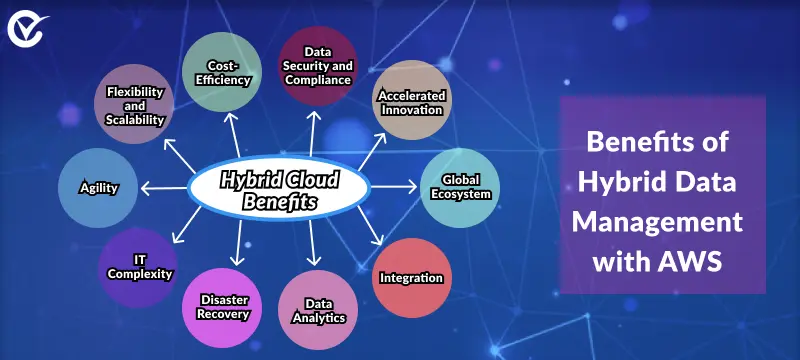In today's data-driven world, organizations are increasingly adopting hybrid data management strategies to leverage the best of both on-premises and cloud environments. Amazon Web Services (AWS) offers a comprehensive suite of tools and services to facilitate hybrid data management, enabling businesses to achieve greater flexibility, scalability, and cost-effectiveness.
This article explores the top 10 benefits of hybrid data management with AWS and provides best practices for successful implementation.
1. Increased Flexibility and Scalability
- Dynamic resource allocation: AWS allows you to easily scale your data infrastructure up or down to meet fluctuating workloads.
- Hybrid deployment options: You can deploy applications and data on-premises, in the cloud, or in a combination of both, providing maximum flexibility.
- Seamless integration: AWS services seamlessly integrate with on-premises systems, allowing you to leverage existing investments.
2. Improved Cost-Efficiency
- Optimized resource utilization: By moving non-critical workloads to the cloud, you can reduce on-premises hardware costs.
- Pay-as-you-go pricing: AWS offers flexible pricing models, allowing you to pay only for the resources you consume.
- Cost optimization tools: AWS provides tools like AWS Cost Explorer and AWS Budgets to help you manage and optimize your cloud spending.
3. Enhanced Data Security and Compliance
- Robust security features: AWS offers a wide range of security features, including encryption, access controls, and compliance certifications.
- Data sovereignty: You can choose to store data in specific regions to comply with data residency requirements.
- Disaster recovery: AWS provides reliable disaster recovery solutions to protect your data from outages and disruptions.
4. Accelerated Innovation
- Access to cutting-edge technologies: AWS offers a wide range of innovative services, such as machine learning, artificial intelligence, and big data analytics.
- Rapid development and deployment: AWS services enable you to develop and deploy applications and services quickly and efficiently.
- Continuous innovation: AWS is constantly introducing new features and services, allowing you to stay ahead of the curve.
5. Improved Business Agility
- Faster time-to-market: By leveraging AWS, you can bring new products and services to market more quickly.
- Increased responsiveness to market changes: You can adapt your data infrastructure to changing business needs more easily.
- Enhanced customer satisfaction: Improved agility can lead to better customer experiences and increased satisfaction.
6. Reduced IT Complexity
- Simplified management: AWS manages the underlying infrastructure, reducing the burden on your IT team.
- Automated provisioning and management: AWS provides tools for automating the provisioning and management of resources.
- Reduced maintenance costs: By moving workloads to the cloud, you can reduce on-premises maintenance costs.
7. Improved Disaster Recovery and Business Continuity
- Redundancy and failover: AWS offers multiple availability zones and regions to ensure data redundancy and business continuity.
- Disaster recovery plans: You can create and test disaster recovery plans to minimize downtime in case of disruptions.
- Compliance with regulatory requirements: AWS can help you meet regulatory requirements for disaster recovery and business continuity.
8. Enhanced Data Analytics and Insights
- Access to big data tools: AWS offers a wide range of big data tools, such as Amazon EMR and AWS Glue, to analyze large datasets.
- Machine learning and AI capabilities: Leverage AWS services to build and deploy machine learning models and AI applications.
- Real-time analytics: Gain insights into your data in real-time using AWS services like Amazon Kinesis and Amazon Athena.
9. Integration with Existing Systems
- Hybrid connectivity: AWS offers various options for connecting your on-premises systems to the cloud, including VPNs, Direct Connect, and AWS Transit Gateway.
- API-driven integration: Use APIs to integrate AWS services with your existing applications and systems.
- Data migration tools: AWS provides tools to help you migrate data from on-premises to the cloud.
10. Access to a Global Ecosystem
- Marketplace: Explore the AWS Marketplace to discover and deploy third-party software solutions.
- Community and support: Benefit from a large and active community of developers and IT professionals.
- Global reach: AWS operates in multiple regions worldwide, providing you with global access to resources and services.
Best Practices for Hybrid Data Management with AWS
- Develop a clear strategy: Define your hybrid data management goals and objectives.
- Assess your workloads: Identify which workloads are suitable for migration to the cloud.
- Choose the right AWS services: Select the AWS services that best meet your needs.
- Implement strong security measures: Protect your data and applications with robust security measures.
- Monitor and optimize performance: Continuously monitor your hybrid environment and optimize performance.
- Leverage AWS best practices: Follow AWS best practices and recommendations.
By following these best practices and leveraging the benefits of hybrid data management with AWS, organizations can unlock new opportunities, improve efficiency, and drive innovation.
Copyrights © December 24 , 2025 All Rights Reserved by Vast Edge Inc.
